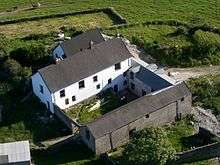Mullacott
Coordinates: 51°10′41″N 4°07′52″W / 51.178°N 4.131°W Mullacott is a small settlement on the A361 road between Ilfracombe and Barnstaple, in Devon, England.[1] It is referred to as 'Mullacott Cross' and forms the crossroads between routes toward Woolacombe, Ilfracombe, Lynton and Braunton. There is an industrial estate, restaurant and horse riding stables.
Lower Mullacott Farm, which is now a rental property through Choice Cottages, is in the Domesday Book under "Molecote". This is the Domesday entry for Molecote:

THE DEVONSHIRE DOMESDAY— EXCHEQUER. 1105
Godebold himself holds Molecote. Alcher held it in the time of king Edward, and it paid geld for half a hide. There is land for four ploughs. There are two ploughs, and two serfs, and five villeins, and two bordars, and one acre of meadow, and ten acres of pasture. Formerly it was worth ten shillings. Now it is worth twenty shillings.
A thegn held one ferling of this land in the time of king Edward. There is one bordar.
Definitions:
Godebold: Was a royal servant and bowman, may have been at the battle of Hastings, there are only three bowmen given land after the conquest. Nicolas, Godebold and Odo.
Alcher: All that is known is that he owned the land before the conquest and was a lord and died in 1086.
King Edward: Known now as 'Edward the Confessor' 1042 - 1066.
Geld: An Anglo-Saxon term for a form of payment or a tax imposed upon landholders.
Ploughs: When the Doomsday book says ‘x ploughs’ it means ‘there are x farms on this manor in addition to the landlords farm’.
Villeins: Wealthiest class of peasant. They usually cultivated 20-40 acres of land (sometimes as much as 100 acres), often as separate strips in different fields. He was also required to work on his lord's land or to provide a service to his lord. When the Domesday book talks of 'x serfs, villeins or bordars' it only counts the head of the family so this number has to be multiplied but four or five to get the true number of population.
Bordar: Middle-ranking peasant, farming more land than a cottager but less than a villein. A typical small holder would have 10-20 acres of land, often as separate strips in different fields. He was also required to work on his lord's land or to provide a service to his lord.
Serfs: Agricultural workers that were tied to the land and owed obligations to the landlord. If a new lord were to take control of a manor, the serfs of the previous lord would remain to work the fields for the new lord. When the Domesday book talks of 'x serfs, villeins or bordars' it only counts the head of the family so this number has to be multiplied but four or five to get the true number of population.
Meadow: A field for growing hay, this was for the use of the landlord and villeins.
Pasture: A field used for arable or grazing.
Thegn: A lord who held his land directly from the king in return for military service in time of war.
Hide: The hide was typically the area of land that could support a family and so it ranged from one area to another (depending upon local conditions). Even though it varied, the typical measurement was sixteen square furlongs (or 120 acres).
Virgate: One quarter of a hide, or two oxgangs. The amount of land that could be tilled during the ploughing season using two oxen. Varied in different regions and soil types. Approx. 30 acres.
Ferling: Literally, quarter of a quarter; normally quarter of a Virgate, itself a quarter of a Hide. But seems to have varied between about two and eight ferlings to the virgate.
Molecote: Mole comes from old French meaning harbour or harbour wall. Cote -'Small shed or shelter for sheep' Anglo Saxon.
References
External links
![]() Media related to Mullacott at Wikimedia Commons
Media related to Mullacott at Wikimedia Commons